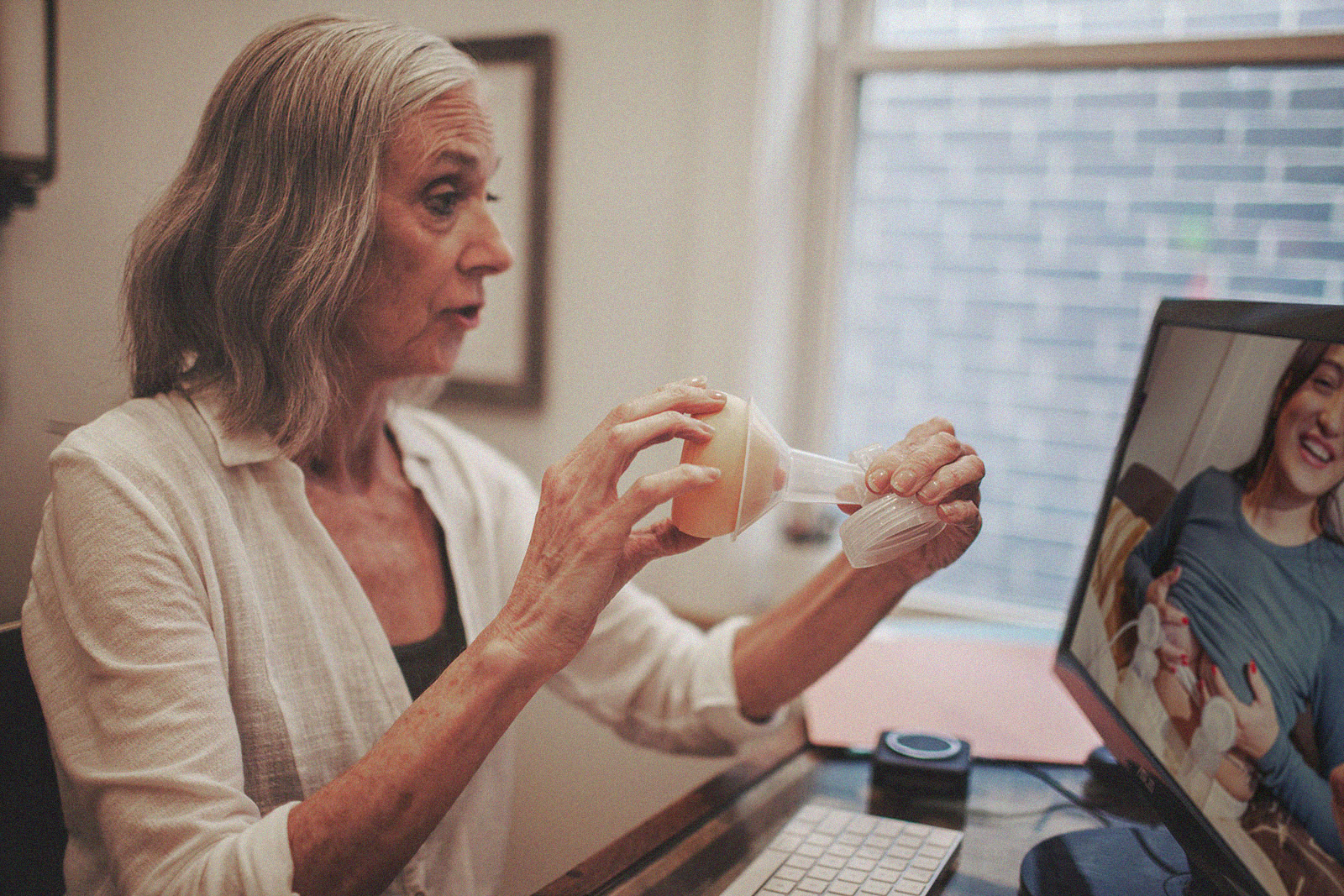How to become an IBCLC and help families thrive
If working as an IBCLC is your dream, you’re in great company — it’s an incredibly fulfilling and important job, providing families with the expert, compassionate care they deserve. But where to start? We talked to TLN’s Director of Clinical Resources Chrisie Rosenthal IBCLC, PMH-C, about the role of an IBCLC, how they can help families thrive, and the education and training it takes to become one.
What is an IBCLC?
Let’s start with the basics: IBCLC stands for International Board Certified Lactation Consultant: The highest credentialed lactation expert with the only internationally recognized certification in the field of lactation. They possess highly specialized clinical skills in breastfeeding assessment, care, and management.
IBCLCs can help with all lactation needs, from latching and breastfeeding positions to finding the right pump and designing a workday pumping schedule. They are also able to address common lactation and infant feeding issues like plugged ducts, mastitis, milk supply concerns, difficulty latching, tongue tie, and breastfeeding pain.
In short, IBCLCs provide care from the prenatal period through weaning for both the breastfeeding parent and infant: One of the most vulnerable and critical times in the life of a parent and their baby.
CLC vs. IBCLC:
What’s the difference?
In your search for a career in lactation care, another certification may have caught your eye: Certified Lactation Counselor (CLC). Though both CLCs and IBCLCs work in lactation, they are markedly different.
A Certified Lactation Counselor or CLC is a professional in lactation counseling, providing breastfeeding advice and education. This certification is often a stepping stone on the path to becoming an IBCLC. CLCs receive 45+ hours of training and are required to complete 18+ hours of continuing education every three years.
An International Board Certified Lactation Consultant or IBCLC is a health care professional and lactation expert holding the most comprehensive lactation certification and highest possible accreditation. It takes multiple years to become an IBCLC, 95 hours of lactation-specific education, between 300 and 1,000 hands-on clinical hours, and 14 college-level health-science specific courses. IBCLCs must also pass a strenuous IBCLC exam and be recertified every five years to maintain their certification.
How to become an IBCLC and build a private practice
From the description above, you can probably tell that becoming an IBCLC is no easy feat. Rosenthal describes it as a long and arduous process, saying, “Most students take three to five years (or more) to complete the requirements and sit for the exam.”
But if you are undeterred by the incredible commitment required, Rosenthal recommends starting with the International Board of Lactation Consultant Examiners (IBLCE), the only credentialing organization for IBCLCs. The IBLCE hosts the IBCLC exam and provides resources and information for aspiring IBCLCs.
Many people become IBCLCs because they are passionate about lactation support. But in addition to your enthusiasm for the work, Rosenthal says, “You will also need to evaluate if you have the time, dedication, and financial resources to complete an IBCLC program.”
Without a doubt, the time and financial requirements it takes to become an IBCLC can be barriers — limiting the opportunities of people from marginalized communities who want to work in lactation care. This, in turn, impacts access to lactation care in those same communities.
Research from the National Library of Medicine shows that strong ethnic/racial, socioeconomic, demographic, and geographic breastfeeding inequities persist in the United States. The lack of culturally sensitive lactation care leaves underrepresented communities even more isolated. “For that reason, it is extremely important that families have access to IBCLCs who reflect their community,” Rosenthal explains.
TLN believes that breastfeeding is a human right, not a privilege. That’s why we are working to make the path to becoming an IBCLC more accessible. The TLN grant program provides financial assistance to aspiring IBCLCs who may not have the financial resources to pursue a career in lactation care. If you want to become an IBCLC, the TLN grant program may be able to help.
As you can tell by now, it takes a lot of hard work and dedication to become an IBCLC, but the payoff is worthwhile. “The relief families feel after a lactation consultation is often immediate. Observing the progress these families make and being a key support person helping them reach their feeding goals over time is incredibly rewarding,” says Rosenthal.
Once you’ve set your heart on becoming an IBCLC, you’ll need to determine which pathway is right for you.
The IBCLC certification pathways
There are three pathways to becoming an IBCLC, each made up of four components:
- Lactation education
- Clinical hours
- Health science education
- Exam
To sit for the exam, you must also adhere to the Code of Professional Conduct for IBCLCs.
Though we’ll cover the basic requirements of each pathway, the IBLCE also provides this pathway decision map to help determine which is right for you.
IBCLC Pathway 1
Recognized health professionals and recognized breastfeeding support counselors
Pathway 1 has two options: One for current health care professionals and one for peer supporters (those without a health care background).
As a Pathway 1 candidate, you must complete:
- 1,000 hours of lactation-specific clinical practice within the five years immediately before your exam application
- If you are a peer supporter, your clinical hours must be supervised
- 95 hours’ worth of lactation-specific education within the five years immediately before your exam application
- Five of those hours must be focused on communication skills
- If you are a peer supporter, your lactation education must be supervised
- 14 subjects outlined in the Health Sciences Education Guide
IBCLC Pathway 2
Accredited lactation academic programs
In Pathway 2, you must complete a comprehensive university or college-based academic program in human lactation and breastfeeding. Your academic program must be accredited by the Commission on Accreditation of Allied Health Education Programs or another accrediting body with equivalent accreditation standards.
As a Pathway 2 candidate, you must complete the following requirements via your academic lactation program:
- 300 hours of directly supervised, lactation-specific clinical practice completed within the five years immediately before your exam application
- The supervising IBCLC must be currently certified and in good standing
- Much like Pathway 1, 95 hours of lactation-specific education completed within the five years immediately before your exam application
- Five of those hours must be focused on communication skills
IBCLC Pathway 3
Mentorship with an IBCLC
Pathway 3 applicants are mentored and supervised by an IBCLC, in accordance with the specifications in the Pathway 3 Plan Guide. Both the mentoring IBCLC’s certification status and your Pathway 3 Plan must be verified by the IBLCE before the beginning of the mentorship and earning clinical hours.
As a Pathway 3 candidate, you must complete:
- 500 hours of directly supervised lactation-specific clinical practice as described in the Pathway 3 Plan Guide within the five years immediately before your exam application
- As with Pathways 1 and 2, 95 hours of lactation-specific education within the five years immediately before your exam application
- Five of those hours must be focused on communication skills
- Health Sciences Education courses
The IBCLC exam
Once you’ve met the requirements of your chosen pathway, it’s test time! All pathways culminate in taking the IBCLC exam, offered twice a year in the spring and fall: March or April (in English) and September (in all IBLCE languages).
The exam comprises 175 multiple-choice questions, given in two parts. This typically takes four hours to complete — but don’t worry, snacks and bathroom breaks are allowed! Exam results are available 10 to 12 weeks after the end of the exam window.
Now what?
You did it! You passed the exam and are officially an International Board Certified Lactation Consultant. Now comes the best part: Helping families get the lactation care they deserve.
As an IBCLC, you can work in several settings helping breastfeeding families, including hospitals and physician offices. But Rosenthal says, “Many IBCLCs work in private practice within their community. Private practice IBCLCs see patients in-home, in an office, or virtually via telehealth.”
However, just because you have a private practice doesn’t mean you’re on your own. That’s where The Lactation Network (TLN) comes in. From prenatal care to weaning, “TLN connects families with IBCLCs for high-quality lactation support, covered by their insurance,“ says Rosenthal. As a TLN IBCLC, we’ll help with insurance billing, marketing materials, and provide a custom IBCLC portal (just to name a few benefits). TLN is here to empower you to make your lactation practice more successful and be the best IBCLC you can be.
—
After all that, if becoming an IBCLC and working as a clinician in the lactation field isn’t a fit for you, that’s okay. There are many other important support roles you can take on in the breastfeeding community. “Become a breastfeeding ally,” says Rosenthal. “Advocate and vote for laws that promote breastfeeding rights and support breastfeeding families. Take steps locally to normalize public breastfeeding and further breastfeeding access. And support your friends and family who are breastfeeding.”
IBCLC or not, we can all do our part to advocate for the expert lactation care parents deserve and help families thrive.
We know what early parenthood is like, and we’ve been there—searching for countless, often conflicting answers online. At The Lactation Network, our International Board Certified Lactation Consultants (IBCLCs) are committed to providing families with trusted, authoritative information about your prenatal-to-weaning journey.
The information in this article is for informational and educational purposes only and is not intended or implied to be a substitute for professional medical advice, diagnosis, or treatment. The content is made available with the understanding that The Lactation Network is not providing professional medical advice on a particular matter. Every family, parent, and care plan is unique—your MD and IBCLC can work with you to ensure you receive the evidence-based, personalized clinical care you deserve. Always consult your clinical team for medical guidance.
We handle billing, end-to-end. We connect you with insurance-covered patients. We help you grow your practice, your way.




